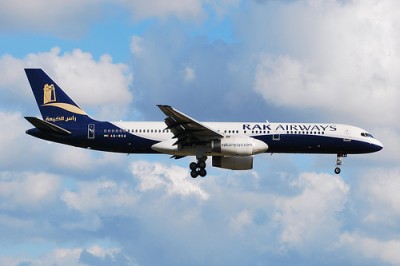
Rak Airways Boeing 757

Rak Airways Boeing 757
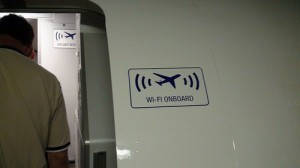
The sign outside of my first Wi-Fi flight back in May.
Yes! I am coming out and predicting that someday Wi-Fi will be free on at least some airlines. I am not talking first class or business class; I am talking about free Wi-Fi for the entire plane. Let me explain…
Southwest Airlines is the newest airline to announce adding Wi-Fi to their flights. Many other airlines already have some or all of their fleets wireless. It took the industry a long time to start becoming wireless, but now almost all US airlines have at least a few Wi-Fi equipped aircraft. The rapid growth shows capitalism at its best. When one airline has Wi-Fi, it provides an obvious advantage over those that do not. However, when almost all airlines in the United States have Wi-Fi, where does one airline stand out over another?
Think about long-distance on landlines (you remember those, right; where wires connected your phone calls?). It used to be mighty expensive to call based on time of day, then there were flat rates per minute, then you could just pay a monthly fee and call whenever and whomever you wanted. The same phenomenon happened with cell phones. Minutes used to be costly, now companies have plans with unlimited minutes, rollover minutes, etc. As competition grows, so do the benefits for the customer.
With Wi-Fi on the airlines, it is a bit more complicated; airlines don’t run the Wi-Fi, independent companies do. Some airlines like American, Delta, and AirTran are using Aircell’s GoGo tower-based Wi-Fi service, but Southwest is using Row44, which is a satellite-based system. Either way, Wi-Fi companies are competitive businesses that have to charge the airlines, so the airlines would need to absorb the costs to provide free Wi-Fi.
I know, with airlines charging fees for everything today, why would an airline ever be willing to absorb the costs? I think we are in a unique time. I don’t expect all these fees to be around forever (at least I hope not). All it would take is one airline. One airline to announce they have free Wi-Fi. It might be years from now when this happens, and it might take a few more years for other airlines to follow. However, this is how things have become cheaper and free in the past. With so many airlines in the US, it is feasible that one might want to come across as a “high-tech”, “medium frills” airline.
Hopefully I am right in this one, but if I am not, I am still willing to pay $13 to access the internet on a flight!
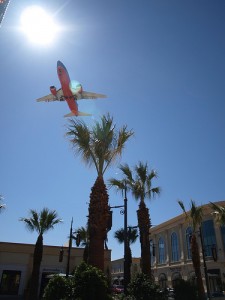
Southwest Airlines flight leaving from Las Vegas, NV
A passenger getting naked on a plane is almost becoming old news. However, I am not tired of blogging about them, so I shall continue. This week’s nudity is brought to you by a Las Vegas bound guy and was found on the Airline Biz Blog.
Southwest Airlines flight 943 left from Oakland and was heading towards Las Vegas when a male passenger exposed himself to a female passenger. That wasn’t enough for him so he decided to hit another female passenger. This was enough for the people aboard and he was restrained.
The crazy man decided this would be a good time to get completely naked and rowdy. Passengers and crew became more aggressive in their restraining and the pilot decided to return the plane back to Oakland.
Image: gTarded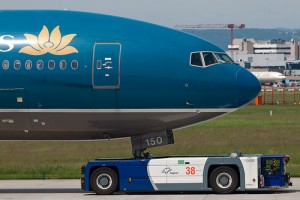
Vietnam Airlines Boeing 777 being towed at Frankfurt
American Airlines, Continental Airlines, Delta Air Lines, United Airlines, US Airways, Southwest Airlines, Alaska Airlines, and UPS have agreed to use up to 1.5million gallons of synthetic diesel made from plant waste per year. The fuel would be used to fuel their ground service equipment at Los Angeles International Airport.
Rentech Inc. will be supplying the alternative fuel starting in 2012, made mostly from urban yard waste and clippings.
Most people only think about aircraft causing much of the pollution in air travel, but there are thousands of support vehicles at each airport that also cause harmful emissions. Rentech is currently in talks with other airlines and airports to increase the fuel’s usage.
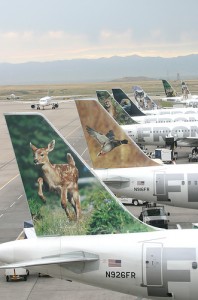
Frontier Airline aircract lined up at Denver
The airline blogosphere (and twittosphere) was abuzz when Southwest Airlines announced their bid for Frontier Airlines. Folks started talking like it was a done deal. Southwest’s bid was $170million versus Republic Airline’s $109million, it seemed there was no question who would be the victor. However, Southwest was unwilling to move forward without a labor agreement and Republic won the right to purchase Frontier Airlines.
The largest roadblock to Southwest’s victory was their plan for the integration of the Frontier pilots. Southwest wanted Frontier pilots to be at the bottom of the seniority list, while Frontier pilots wanted equal treatment and the ability to stay in Denver (where Frontier is based).
If this all goes through (the shareholders still need to give their approval), it will create a very interesting airline. Republic already serves as a regional carrier for larger airlines (AmericanConnection, Continental Express, United Express, US Airways Express and Delta Connection). This summer, they purchased Midwest to expand their fleet and routes. Knowing how Republic works, I doubt they will combine their airlines under one brand. They have already talked about moving aircraft between Midwest and Frontier, but for now, the cute animals get to stay. I am sure there will be some consolidation between the airlines to save money, but probably for most people it will look like two separate airlines.
It will be interesting to see how Frontier and Midwest grow and of course how Southwest will grow (or shrink) at Denver.
Image: BFIguy